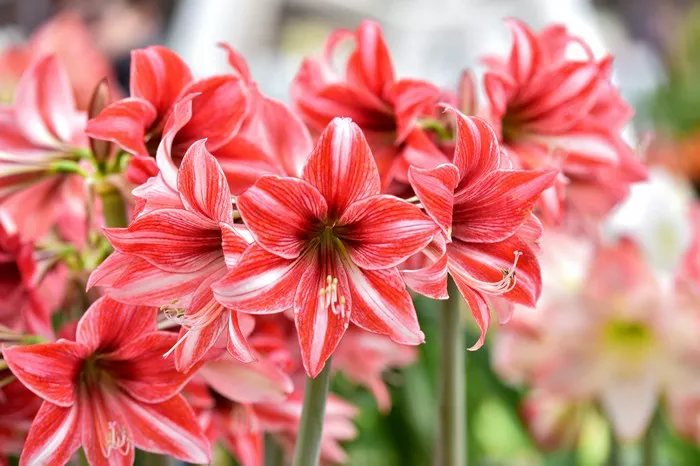Flowers, with their vibrant colors, delicate petals, and enchanting fragrances, have long been cherished for their ability to adorn landscapes, express emotions, and symbolize various sentiments. Among the vast array of floral species, those beginning with the letter “A” exude their own unique charm and elegance. In this comprehensive guide, we embark on a journey to discover and appreciate the diverse world of flowers that proudly bear the initial “A.”
1. Allium
Scientific Name: Allium spp.
Overview: Alliums, commonly known as ornamental onions, belong to the same family as onions, garlic, and chives. These captivating flowers are renowned for their spherical clusters of small blooms atop long, slender stems, adding architectural interest to gardens.
Appearance: Allium flowers come in various shades of purple, pink, white, and blue, often resembling colorful orbs floating above the foliage. Their distinctive shape and structure make them an eye-catching addition to both formal and informal garden settings.
Growing Conditions: Alliums thrive in well-drained soil and prefer full sunlight. Planting them in the fall allows for spring blooms, and they are relatively low-maintenance, making them a favorite among gardeners.
2. Amaryllis
Scientific Name: Hippeastrum spp.
Overview: Amaryllis is renowned for its striking blooms, making it a popular choice for indoor cultivation. Native to South America, these flowers are prized for their large, trumpet-shaped blossoms and vibrant colors.
Appearance: Amaryllis flowers boast large, showy petals that come in various hues, including red, pink, white, and orange. Their dramatic appearance makes them a focal point in any floral arrangement or garden display.
Growing Conditions: Amaryllis bulbs are typically planted in pots indoors, requiring well-drained soil and ample sunlight. With proper care, they can produce spectacular blooms during the winter months, bringing warmth and color to indoor spaces.
3. Azalea
Scientific Name: Rhododendron spp.
Overview: Azaleas are prized for their exquisite flowers and lush foliage, making them a beloved choice for gardens and landscapes. These flowering shrubs belong to the Rhododendron genus and are celebrated for their vibrant blooms.
Appearance: Azalea flowers come in a myriad of colors, including shades of pink, red, purple, white, and orange. Their delicate petals form clusters of blooms that adorn the branches, creating a stunning display during the spring season.
Growing Conditions: Azaleas prefer acidic soil and partial shade, making them well-suited for woodland gardens or shaded landscapes. With proper care, these hardy shrubs can thrive for years, rewarding gardeners with their breathtaking floral show.
4. Aster
Scientific Name: Aster spp.
Overview: Asters are renowned for their daisy-like flowers and prolific blooming habits, making them a favorite among gardeners and floral enthusiasts. These versatile perennials are valued for their resilience and ability to attract pollinators.
Appearance: Aster flowers feature a distinctive daisy-like shape, with vibrant petals surrounding a central disc. They come in a wide range of colors, including shades of purple, blue, pink, and white, adding a cheerful touch to gardens and landscapes.
Growing Conditions: Asters thrive in well-drained soil and full sunlight, although they can tolerate partial shade in hotter climates. With regular watering and deadheading, these resilient perennials can bloom profusely from late summer to fall, extending the garden’s color palette well into the autumn months.
5. Anemone
Scientific Name: Anemone spp.
Overview: Anemones, also known as windflowers, are celebrated for their delicate blooms and graceful appearance. These perennial plants belong to the Ranunculaceae family and are prized for their early spring blossoms.
Appearance: Anemone flowers feature cup-shaped blooms with brightly colored petals and a prominent center. They come in various shades, including white, pink, purple, and blue, adding a touch of elegance to gardens and borders.
Growing Conditions: Anemones thrive in well-drained soil and partial shade, making them ideal for woodland gardens or dappled sunlight areas. Planting them in the fall allows for spring blooms, and they can be grown from rhizomes or tubers, providing years of beauty with minimal care.
6. Anthurium
Scientific Name: Anthurium spp.
Overview: Anthuriums, also known as flamingo flowers or laceleaf, are prized for their exotic appearance and long-lasting blooms. Native to tropical regions, these flowering plants are revered for their glossy foliage and vibrant spathes.
Appearance: Anthurium flowers are characterized by their glossy, heart-shaped spathes, which come in various shades of red, pink, orange, and white. Contrasting with their glossy foliage, these striking blooms add a tropical flair to indoor spaces and gardens.
Growing Conditions: Anthuriums thrive in humid, tropical environments and prefer well-drained soil and indirect sunlight. Regular watering and misting help maintain optimal moisture levels, while providing adequate airflow prevents fungal diseases. With proper care, these exotic plants can thrive and bloom year-round, adding a touch of tropical splendor to any setting.
Conclusion
From the architectural elegance of Alliums to the tropical allure of Anthuriums, flowers beginning with the letter “A” encompass a diverse array of shapes, colors, and characteristics. Whether adorning gardens, bouquets, or indoor spaces, these floral treasures captivate with their beauty and charm. By exploring the unique qualities of each “A” flower, gardeners and enthusiasts alike can gain a deeper appreciation for the wonders of the natural world and the boundless creativity it inspires.


